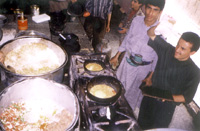
Saltah, Very Special Yemeni Dish [Archives:2000/35/Culture]
August 28 2000

First take a reasonable quantity of fenugreek; dissolve it in water.
Keep it for one hour. Then prepare meat or chicken soup.
A special bowl called Madr or Makli is used to cook Saltah. It is heat-proof. Put the empty bowl on fire for five minutes. Then pour some cooking oil, then some onions, to be followed by some fresh tomatoes. Mix all well. Now add some pepper and one or two eggs. Then put some fresh potatoes. Mix well again; then add some soup as desired. Add some minced meat. The whole mixture is to be cooked for ten minutes.
Remove the bowl from the fire. Remove water from your fenugreek (called Hulbah) and pour it into the hot bowl. (Do not pour fenugreek while the bowl is on the fire or else it becomes bitter in taste). The fenugreek shall become coagulated at the bottom of the bowl. Now mix some citric acid. The whole mixture is to be mixed until it is souped up. Add salt according to taste.
Although it is the last item at lunch, it has to remain hot. People like it hot.
Kinds of Saltah:
We can say that the preparation of Saltah is always quite the same; but it has now been developed. Instead of minced meat, fresh meat is used. It is called Fahsah.
Advantages of Saltah
This dish is served at lunch. It is very delicious and tasty. It stimulates the appetite. Qat chewers like it before chewing qat. They say Saltah makes them taste qat tasty too. It gives energy to people living in mountainous and cold areas. It gives heat to the stomach and eases digestion.
Sanaa Saltah is considered to be the best in Yemen. This dish has already crept into Taiz Province and , after Unification, to the Southern provinces of Aden and Abyan also. Saltah is prepared also in those countries where Yemeni residents reside.
——
[archive-e:35-v:2000-y:2000-d:2000-08-28-p:./2000/iss35/culture.htm]


